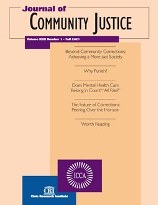What Works With Women Offenders in the Community in Canada: Research and Best Practices
Author: Shandy-Lynn Briggs.; Kelly Taylor.
Source: Volume 21, Number 03, Spring 2012 , pp.5-9(5)

< previous article |next article > |return to table of contents
Abstract:
In 1989, the Task Force on Federally Sentenced Women was created in order to examine the lives, experiences, and broader social context of women serving federal sentences in Canada. The ensuing report, Creating Choices (1990), shared the opinions and perspectives of women offenders, aboriginal persons, individuals with a special interest in the needs and lives of incarcerated women, and individuals who had past experience with women in Canada’s criminal justice system and knowledge on research pertaining to women offenders. There have been significant improvements achieved over the past 20 years and significant increases in partnering opportunities between the CSC and a variety of stakeholders. Nevertheless, there are continuing challenges experienced for women in Canada’s criminal justice system as increasing numbers of women are entering the system. In order to continue to support the five guiding principles of Creating Choices , while also contributing to an action plan for women’s corrections in Canada, in September 2010, the Women Offender Sector of the CSC hosted an international forum to develop a framework for the future of women’s corrections in Canada. This article summarizes the most important research results presented at the forum.Keywords: Accommodation challenges; geographic dislocation; community-based alternatives; gender-specific initiatives
Affiliations:
1: Correctional Services of Canada; 2: Correctional Services of Canada.